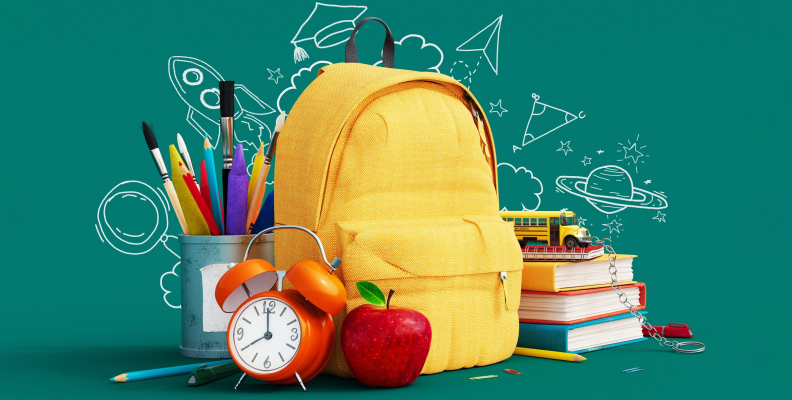Help Your Child Ace This School Year
It’s time to take notes: Help your child succeed this school year with these helpful back-to-school tips.
It’s hard to believe, but summer has come to an end and school is already back in session! While we can’t provide every student with the secret to passing their courses, we can provide some helpful tips for parents to help set their children up for success.
Back-to-School Tips for Your Family
1. Take small steps to adjust to big changes
New things are scary for everyone. It’s completely normal if your child is experiencing the new-school-year-jitters—especially if it’s their first year or if they’ve transferred to a different school. It’s important to validate your child’s feelings while reminding them that everyone gets nervous sometimes, including parents and teachers. You can also help ease their nervousness by shifting the focus to all the fun things they love about school!
2. Make mental health a priority
School is a major priority for students, so it naturally comes with stressors. This has been especially true in the past few years as children faced a global pandemic and an uptick in natural disasters—leading to an increase in childhood and teen anxiety, depression, and other mental health conditions. Knowing this, it’s more important than ever to check in on your child and to note any emotional and/or behavioral changes. There are fortunately plenty of resources available to help children address any mental health struggles, including the ones listed below.
Looking for mental health support for your child?
Check out these available resources:
El Paso Center for Children’s Counseling & Life Services
Many people struggle with mental health at some point in their lives. Counseling is available through El Paso Center for Children, with the option for sessions to take place in person or online. The length and frequency of each session can be determined by you and the counselor.
SAMHSA’s Parent & Caregiver Resources
The Substance Abuse and Mental Health Services Administration (SAMHSA) provides parents and other caregivers with a wide variety of resources to find support for children and teens struggling with mental health concerns.
In this Digital Age, many people find it easier to talk to someone virtually. This free, confidential text line is available to anyone in the US; all you have to do is text HOME to 741741 to get connected to a trained crisis counselor—and all from a secure platform.
If you or your child are in a suicidal, mental health, and/or substance abuse crisis, dial 988 for 24/7 free and confidential support.
3. Address bullying as soon as you spot it
It seems that for as long as students have been going to school, there have been bullies. It’s an unfortunate reality that could make or break a child’s experience this school year. While you can’t predict if your child will be bullied, there are things you can do if it happens: Alert the school, teach your child how to respond to bullying (whether it’s directed at them or another student), encourage your child to make friends both in and out of school, and monitor any changes in their behavior. It’s also important to recognize if your child becomes the bully so you can address and correct their behavior as soon as possible, while addressing any underlying cause of their bullying.
4. Keep digital safety in mind
Students are now faced with the real world and the digital one. This can be a great way for them to find new hobbies, interests, and communities that keep them engaged. It’s also a space where misinformation, cyberbullies, and other risks exist. Monitor any use of technology being used by young children and use this school year to teach children of all ages digital media literacy. This can help keep them safe and also creates a more enriching online environment for them.
5. Have a plan in place before and after school
It’s natural to worry how your child is doing throughout the school day. However, it’s just as important to make sure they get to school and return home safely. Have a plan in place for getting to and from school safely, and consider practicing it with younger children to ensure they feel comfortable—whether it’s showing them where to walk, get the bus, or meet a caregiver for after-school pickups. In addition to planning a child’s commute, you can also alleviate some worry by ensuring you have before- and after-school care in place for any little ones. (And don’t forget to inform your child and their teacher who is allowed to pick your child up from school!)
6. Create routines and build healthy habits
Children are constantly learning and growing, so it’s important they build good habits that support their development and encourage them to become happier, healthier, and more confident! Some examples of healthy practices to instill in your child this school year include creating morning and bedtime routines, encouraging reading, supporting healthy sleeping, and starting the child’s day with a nutritious breakfast. Most importantly, remember consistency is key to building and maintaining these new healthy habits.
7. Dedicate a space for your child to work
Your child’s biggest responsibility right now is being a student. Set them up for success this school year by providing them with space to study, read, and/or complete their homework, as well as rules for completing their assignment—such as no TV before completing their homework. Having a dedicated space, such as a desk or even the kitchen table, helps reduce distractions (this is especially crucial for neurodivergent children) and increases the chance of successful outcomes.
We hope this guide is helpful and that this school year is off to a great start for you and your little ones!
For more tips and resources for parents, visit the El Paso Center for Children blog.
Resources & References
- American Academy of Pediatrics. (2024, August 5). Back-to-School Tips for Families. HealthyChildren.org.
- Everett, A. (2024, August 22). Back to School: Mental Health Tips and Resources to Help Youth Thrive in – and out of – the Classroom. SAMHSA: Substance Abuse and Mental Health Services Administration.
- GetParentingTips.com Staff. (n.d.-a). 7 Ways to Prepare for the New School Year. GetParentingTips.com.
- GetParentingTips.com Staff. (n.d.-b). It’s Back to School Time! GetParentingTips.com.





